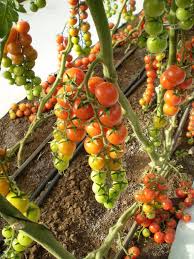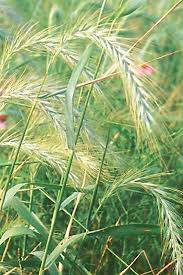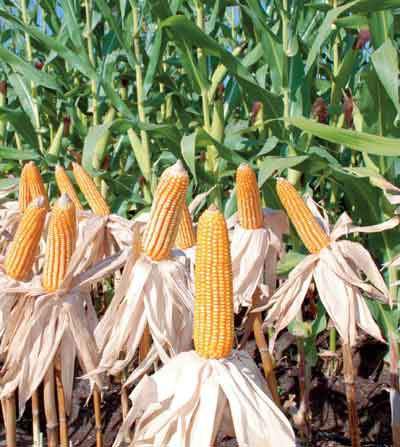



Tomatoes are an important horticultural commodities, but good production quantity and quality is still low. This is due among other things the hard ground, poor micro nutrients and hormones, are not balanced fertilization, pest and diseases, the influence of weather and climate, and farmers' cultivation technical
PT. Natural Nusantara seeks to help farmers in increasing production quantity and quality while maintaining environmental sustainability (Aspects of K-3), so that farmers can compete in the era of free trade.
A. PHASE PREPLANTING
1. " onmouseover="this.style.backgroundColor='#ebeff9'" onmouseout="this.style.backgroundColor='#fff'">Growing Conditions>
- Tomatoes can be planted in lowland / upland
- The soil loose, and fertile, a little clay containing sand and a pH between 5 to 6
- Rainfall 750-1250 mm / year, high rainfall can hamper persarian.
- High relative humidity around 25% will stimulate the growth of young plants for the assimilation of CO2 for the better through the stomata are open more, but will also stimulate nuisance plants and microorganisms are harmful to plants
2. Planting Pattern
- Plants are recommended are corn, rice, sorghum, cabbage and beans
- Suggested planting or intercropping system during the plant to provide conditions that are less favored by the organism remains a bully
3. Land Preparation
- Select loose and fertile land previously planted with tomatoes, peppers, eggplant, tobacco and potatoes.
- To reduce soil nematodes in soil with water for two weeks
- If the low pH dolomite lime give 150 kg/1000 m2 and the average spread and stirred at the age of 2-3 weeks before planting
- Make 120-160 cm-wide beds for a double row and 40-50 cm for a single row
- Make a trench 20-30 cm wide beds with a depth of 30 cm for water disposal.
- Provide basic fertilizer 4 kg urea / ZA + TSP + 7.5 kg KCl per 4 kg over 1000 m2 beds, mix and spread with soil
- Or if you use NPK Compound Fertilizer (15-15-15) dose ± 20 kg / 1000 m2 mixed into the ground on the beds.
- Give NASA POC fertilizer that has been mixed with water evenly over the beds, 1-2 doses bottle/1000 m2. The results will be better if replaced SUPER NASA (dose ± 1-2 bottle/1000 m2) by:
- Alternative 1: 1 bottle of NASA SUPER diluted in 3 liters of water used as the main solution. Then each was given 50 liter water 200 cc of solution was to flush the main beds.
- Alternative 2: every 1 volume of 10 pl publicity given to eat 1 tablespoon SUPER + NASA for 10 meters water beds
- Distribute Natural GLIO 1-2 sachets mixed manure (+ 1 week) evenly on the beds in the afternoon
- If you use plastic mulch, cover beds in the daytime
- Leave for 5-7 days before planting
- Make the planting hole with a distance of 60 x 80 cm or 60 x 50 cm on the beds, 7-8 cm diameter 15 cm deep
4. Seed Selection
- Select resistant varieties and types Hybryda (F1 Hybryd)
- Seed leaf leaves 5-6 (HSS = 25-30 days after seedling) move into the field
- To reduce the initial stress need to flush old growth in the late afternoon the day before planting or in the morning (so moist)
B. PHASE seedbed (0-30 HSS)
- Prepare the planting medium is a mixture of soil and manure from 25 to 30 kg + Natural GLIO (1:1)
- Enter the polibag plastic or contongan banana or coconut leaves
- Sebarlah seeds evenly or enter one by one in polibag
- After a 8-10 day-old seedlings, choose a good seed, strong and moved in healthy place banana leaves or a mixture containing planting media
- Watering is done every day (see the condition of the soil)
- Spraying NASA POC at the age of 10 and 17 days with a dose of 2 cap / tank
C. INVESTMENT PHASE (0-15 HST = Days After Planting)
- Beds are watered the day before (dilep) first
- Ready for planting seeds aged 3 - 4 weeks, 5-6 leaves
- Planting afternoon
- Open plastic polibag
- Immerse the seeds in a shallow bar at the base boundary and backfilled with soil in the surrounding
- Finish planting directly sprayed with NASA POC 2-3 doses + cap per 15 liters of water
- Search plants die until the age of 2 weeks, how plants are dead, damaged, wilted or abnormal growth is revoked, then created a new planting hole, cleaned and then GLIO Natural seedlings planted
- Watering done every day until the tomatoes grow normally, be careful not to be excessive because the plants grew, not able to absorb nutrient elements and susceptible to disease
- Examine soil pests such as caterpillars and the caterpillars. If there are attacks by Natural spray VITURA
- Observe diseases such as Fusarium wilt disease or bacteria, and late blight, control by spraying GLIO Natural sugar mixed 1:1 ratio. Virus diseases, such as Thrips vector control, flea kebul (Bemissia tabaci), sissy (Aphis sp.), Flea peach (Myzus sp.) And mites (Tetranichus sp.) By spraying Natural Pestona BVR or alternately
- Place the stake as early as possible so the roots are not damaged stake impaled with 10-20 cm distance from the stems of tomato
D. Vegetative phase (15-30 HST)
- If no mulch, weeding and giving at the age of 28 HST same friable and aftershocks followed the provision gift fertilizer plant
- After the plant life around since the 1st week of planting, given urea and KCl with a ratio of 1:1 for each plant (1-2 grams), giving the plant at a distance of around ± 3 cm from the stems of tomato plants and then covered with soil and water flush
- Fertilization both be aged 2-3 weeks after planting a mixture of urea and KCl (± 5 g), give plants around as far as ± 5 cm and depth of ± 1 cm and then covered with soil and water flush.
- When the age of 4 weeks the plants were still visible not fertile can be cultivated again Urea and KCl (7 grams). Distance accumulation of stem made further (± 7 cm).
- If you do not need to use mulch and weeding and fertilizer supplement given by poured
- Watering done in the morning or evening
- Observe pests and diseases such as caterpillars, lice-alliance, withered and viral diseases, in the event of an attack such as the phase control of plant
- Spray the NASA POC (closed 4-5) per tank or NASA POC (closed 3-4) + HORMONIK (1 cap) every 7 days.
- Plants that have reached a height of 10-15 cm should be tied to the stake and every rising + 20 cm should be tied back to the tomato stems upright.
- Binding not too closely with the model number 8, so that no friction occurs between the marker rod that can cause injury.
E. PHASE generative (from 30 to 80 HST)
1. Crop Management
- If no weeding and mulch made gift second 45-50 days age
- To stimulate flowering at the age of 32 HST doing shoots picking unproductive once every 5-7 days, so stay 1-3 primary branches / plant
- Picking better morning scars picking to dry quickly in a way; end of the shoot was held with clean hands and moved from side to side until the buds break. Shoots are already a large branches should be cut with a knife or scissors, while the plant is limited picking height must be careful to not come last shoots picked so that plants are not too short
- The height of plants can be limited by cutting edge when the number of plants group of fruits reaches 5-7
- Spray POC HORMONIK NASA and once every 7-10 days with a dose of 3-4 and close 1-2 NASA POC HORMONIK cap / tank. - To not be easily removed by rain water and add the adhesive evenly Straighten AERO 810 with the dose 5 ml (1 / 2 cap) / tank.
2. Observations Pests and Diseases
- Caterpillar fruit (Helicoperva armigera and Heliothis sp.). Symptoms of fruit and dirt accumulated holes in the fruit is attacked. Perform collection and destruction of infected tomato fruit, spray with PESTONA
- Fruit fly (Brachtocera or Dacus sp.). Symptoms of esophageal fruit rot fungi and when the fruit will split the white larvae appear. - - As a agravator, namely as a vector of disease fungi, bacteria and Drosophilla sp. Collect and burn infected fruit, use a male fruit fly trap (can be mixed with insecticide)
- Rotten leaves (Phytopthora infestans), leaf and fruit spot (Alternaria solani) and antraknose fruit rot (Colletotrichum coccodes). If there are attacks by Natural spray GLIO
- If the pest and disease control by using natural pesticides (PESTONA, GLIO, VITURA) can be used not overcome the recommended chemical pesticides. In order to spray chemical pesticides is more evenly distributed and not easily removed by rain water add 810 AERO Straighten Adhesives, dose + 5 ml (1 / 2 cap) / tank.
- Bad end of the fruit. The tip of the fruit was black and foul circle. This deficiency symptoms Ca (Calcium). Give Dolomite.
F. PHASE & POST HARVEST HARVEST (80 to 130 HST)
- Harvest at the age of HST with the features 90-100; fruit skin color changed from green to yellow, the edge of the old leaves dry, yellow stem, in the morning or late afternoon while the weather clears. Fruit fruit stalks twisted until broken. Fruit twist done one by one and selected fruit ready to pick. Enter a basket and put in the shade
- Interval picking 2-3 days.
- To be durable, not quickly decay and not easy bruising, tomatoes harvested will be consumed fresh half-baked
- Container which is good for transport crates with a board and do not slam have gap
- Beware of fruit rot disease Antraknose, collect and destroy
- Tomato fruit has been picked, cleaned, sorted and then transported in packing ready for consumption.





















